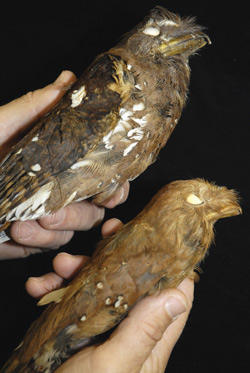|
|
|
 |
|---|
A new genus of frogmouth bird (top) found in the Solomon Islands by Florida Museum of Natural History ornithologists Andrew Kratter and David Steadman may be closely related to another genus found in the Philippines (bottom).
|
Your bird field guide may be out of date now that University of Florida scientists have discovered a new genus of frogmouth bird on a South Pacific island.
New genera of living birds are rare discoveries — fewer than one per year is announced globally. David Steadman and Andrew Kratter, ornithologists at the Florida Museum of Natural History, turned up the surprising new discovery on a collecting expedition in the Solomon Islands. Theirs is the first frogmouth from these islands to be caught by scientists in more than 100 years.
Kratter and Steadman are co-authors of a study analyzing the frogmouth’s morphology, or physical form, and DNA in comparison to two other living genera of frogmouths. The findings were published in the journal Ibis: The International Journal of Avian Science. The paper describes the bird as a new genus and species, now named Rigidipenna inexpectata.
“This discovery underscores that birds on remote Pacific islands are still poorly known, scientifically speaking,” Steadman said. “Without the help of local hunters, we probably would have overlooked the frogmouth.”
Originally, the bird was misclassified as a subspecies of the Australian Marbled Frogmouth, Podargus ocellatus. The blunder went undetected for decades, until a collecting trip led by Kratter in 1998 turned up a specimen on Isabel, a 1,500-square-mile island in the Solomons. Today, the only museum specimen of this bird in the world, with an associated skin and skeleton, is housed at the Florida Museum of Natural History.
Frogmouths are predatory birds named for their strikingly wide, strong beak that resembles a frog’s mouth; but their beak also sports a small, sharp hook more like an owl’s. Steadman said their beaks are like no other bird’s in the world. They eat insects, rodents, small birds — and yes, even frogs.
For perspective on the scale of evolutionary difference between genera, consider that modern humans and Neanderthals are different species within the same genus (Homo), while chimpanzees are our living relatives from a closely related genus (Pan), but that we share the same taxonomic family (Hominidae) with our chimp cousins.
The Solomon Islands Frogmouth differs from other frogmouths in a number of significant ways. First, it is probably not as accomplished of a flier because its eight tail-feathers, instead of the typical 10 to 12 on other frogmouths, curtail its lift potential, and its much coarser feathers reduce maneuverability.
“These are island adaptations that work to keep the bird on the island,” Steadman said.
Second, it has distinct barring on the primary wing feathers and tail feathers, where other frogmouths are more uniform. Its speckles are larger, and the white spots on its breast and underbelly are more pronounced than on other frogmouths.
Two other genera of frogmouths exist: one in southeast Asia and the other in Australia and New Guinea. The Solomon Islands Frogmouth is known to inhabit three islands: Isabel, Bougainville and Guadalcanal.
Nigel Cleere of the The Natural History Museum in the United Kingdom is the lead author for the paper and additional co-authors include: Michael Braun and Christopher Huddleston of the Smithsonian Institution, Christopher Filardi of the University of Washington and Guy Dutson.
David Steadman, dws@flmnh.ufl.edu
Andrew Kratther, kratter@flmnh.ufl.edu
DeLene Beeland
